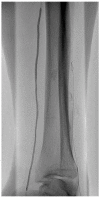Chronic Limb-Threatening Ischemia and the Need for Revascularization
- PMID: 37048765
- PMCID: PMC10095037
- DOI: 10.3390/jcm12072682
Chronic Limb-Threatening Ischemia and the Need for Revascularization
Abstract
Background: Patients presenting with critical limb-threatening ischemia (CLTI) have been increasing in number over the years. They represent a high-risk population, especially in terms of major amputation and mortality. Despite multiple guidelines concerning their management, it continues to be challenging. Decision-making between surgical and endovascular procedures should be well established, but there is still a lack of consensus concerning the best treatment strategy. The aim of this manuscript is to offer an overview of the contemporary management of CLTI patients, with a focus on the concept that evidence-based revascularization (EBR) could help surgeons to provide more appropriate treatment, avoiding improper procedures, as well as too-high-risk ones.
Methods: We performed a search on MEDLINE, Embase, and Scopus from 1 January 1995 to 31 December 2022 and reviewed Global and ESVS Guidelines. A total of 150 articles were screened, but only those of high quality were considered and included in a narrative synthesis.
Results: Global Vascular Guidelines have improved and standardized the way to classify and manage CLTI patients with evidence-based revascularization (EBR). Nevertheless, considering that not all patients are suitable for revascularization, a key strategy could be to stratify unfit patients by considering both clinical and non-clinical risk factors, in accordance with the concept of individual residual risk for every patient. The recent BEST-CLI trial established the superiority of autologous vein bypass graft over endovascular therapy for the revascularization of CLTI patients. However, no-option CLTI patients still represent a critical issue.
Conclusions: The surgeon's experience and skillfulness are the cornerstones of treatment and of a multidisciplinary approach. The recent BEST-CLI trial established that open surgical peripheral vascular surgery could guarantee better outcomes than the less invasive endovascular approach.
Keywords: chronic limb-threatening ischemia; endovascular treatment; lower-limb revascularization; peripheral arterial disease; peripheral bypass.
Conflict of interest statement
The authors declare no conflict of interest.
Figures
References
Publication types
LinkOut - more resources
Full Text Sources
Research Materials
Miscellaneous





